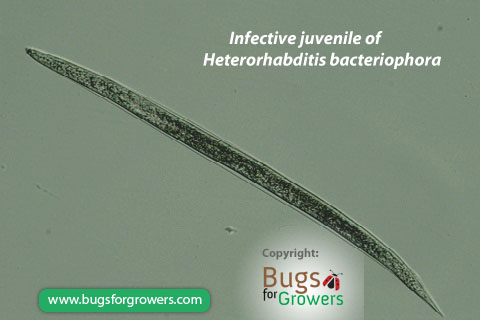Biological control of Mexican fruit flies with beneficial Heterorhabditis bacteriophora nematodes
Heterorhabditis bacteriophora nematodes are beneficial insect parasitic nematodes. These nematodes are also called as entomopathogenic nematodes that are known to infect, kill and reproduce in soil-dwelling stages of many different kinds of insect pests. These naturally occurring insect parasitic nematodes can be commercially produced using larvae of insects like wax worms, Galleria mellonella (Photo 1) and mealworms, Tenebrio molitor (Ehlers and Shapiro-Ilan, 2005). Currently, they are also produced in the big fermenting tanks containing liquid media cultured with their symbiotic bacteria called Photorhabdus luminescens as their food (Ehlers and Shapiro-Ilan, 2005). Infective juveniles of Heterorhabditis bacteriophora nematodes (Photo 2) always carry Photorhabdus luminescens bacteria in their guts. Heterorhabditis bacteriophora nematodes enter in the body cavity of their insect hosts through natural openings such as mouth, anus, spiracles and even through cuticle. After entering into host’s body cavity, nematodes release symbiotic bacteria in the insect blood where bacteria multiply, cause septicemia and kill insect host usually within 48 h after infection. Beneficial Heterorhabditis bacteriophora nematode is considered as warm temperature adapted nematode because it is very active and effective in killing insect pests in the field when temperature is above 20°C (68°F).


Mexican fruit fly, Anastrepha ludens are one of the most important pests of apple, avocado, citrus, custard apple, grapefruit, mango, pear, peach and pomegranate. Fruit fly adults are yellowish brown and about 11 mm long. Mature larvae of fruit fly are whitish, 12 mm long and ventrally curved. Female fruit flies generally lay eggs in groups of 10 eggs in fruits. Eggs hatch within 10-12 days into small larvae called maggots that immediately start feeding on the pulp of fruits. While feeding, the larvae mature inside the fruits. The matured larvae the leave fruits via small exit holes and fall on the ground and then pupate in the soil.
These mature larvae and pupae of Mexican fruit flies can be easily targeted and killed using beneficial entomopathogenic nematodes like Heterorhabditis bacteriophora. Commercially produced nematodes have showed a great potential to use them as excellent biological control agents for controlling Mexican fruit flies that cause serious damage to many fruits like citrus and mango. Recently, Toledo et al (2014) demonstrated that the beneficial Heterorhabdtis bacteriophora nematodes can cause about 80% mortality of third stage maggots of Mexican fruit flies under laboratory conditions.
Research Papers:
- Ehlers, R.-U. and Shapiro-Ilan, D. I. 2005. Mass production. In: Nematodes as biocontrol agents. Grewal, P. S., Ehlers, R.-U. and Shapiro-Ilan, D. I. (Eds.). CABI Publishing,UK. pp. 65-78.
- Toledo, J., Sanchez, J.E., Williams, T., Gomez, A., Montoya, P. and Ibarra, J.E. 2014. Effect of soil moisture on the persistence and efficacy of Heterorhabditis bacteriophora (Rhabditida: Heterorhabditidae) against Anastrepha ludens (diptera: tephritidae) larvae. Florida Entomologist 79: 528-533.
